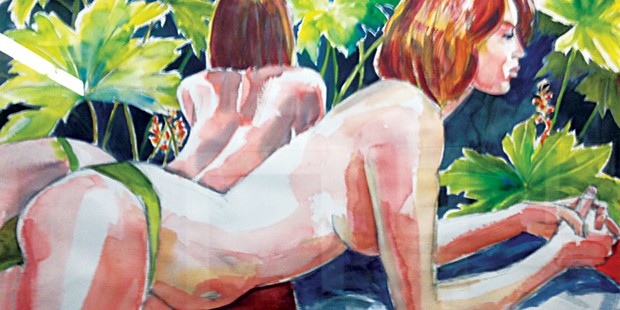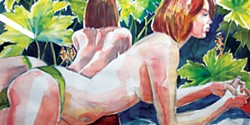[
{
"name": "Top Stories Video Pair",
"insertPoint": "7",
"component": "17087298",
"parentWrapperClass": "fdn-ads-inline-content-block",
"requiredCountToDisplay": "1"
}
]
If you missed the annual open studio event at Arcata's StewART studio spaces last week featured new and in-progress paintings, prints and drawings by Carol Andersen, Joyce Jonté, Patricia Sennott, Laura Corsiglia and Peter Lisle, don't worry. The artists' work is available for viewing by appointment through next month. Sennott's studies of flora and fauna emphasize detail and bright, translucent color. Jonté is showing tautly rendered watercolor views of nudes in garden settings. Anderson, who primarily paints birds and animals, showed paintings, etchings and woodcuts of ravens, snakes, deer and octopi. Lisle and Corsiglia, the guests taking part in this year's open studio event, work respectively in realist and surrealist styles.
The StewART space is located in a basement suite smelling faintly and pleasantly of art supplies inside the stately old Stewart School Office building on 16th Street, across from Arcata High School. The close-knit group of studiomates who work there have been in residence since 2004. Since that time, the studios have maintained a presence as a social and professional hub for Arcata artists. In addition to providing members and guests with workspace and informal exhibition opportunities, the studios also host the Arcata Life Drawing Circle, organized by Jonté and Steven Vander Meer, which is open to the public on a regular basis.
Sennott's watercolor studies and prints feature plants and animals in bright translucent colors, suggesting tropical heat and light. Some of her most memorable images are monotypes — images produced through a hands-on printing process yielding one-of-a-kind results. In the studio, where it's possible to see multiple iterations of a print side by side, you can see how each print in an edition negotiates intent and chance in a completely independent way.
"To make a monotype, I roll ink onto a sheet of hard plastic and wipe away ink with cotton swabs and towels to form an image," Sennott writes. "The wiped plate is placed on the bed of an etching press, covered with damp archival paper and then pushed through the press. The pressure forces the ink into the paper fibers. What comes out of the press is always a surprise!"
The contemplative quality of Sennott's flora-and-fauna studies is matched by the serene detachment of the lovely, remote nudes in Jonté's watercolors. Color in these works is clear and translucent; efficient, flickering brushwork evokes a variety of 20th century reference points, from pinup magazines to fashion illustration.
Andersen's pictures of animals and birds communicate volumes, not only with regard to their subjects' physical earmarks but also to their manner of being. Etchings of half-grown raven chicks, based on observations Andersen made while working as a volunteer at the Humboldt Wildlife Care Center, exude fledgling energy and puckish intelligence. The black-tailed buck she painted for the cover of local band Neighbors' recently released EP telegraphs an exquisitely reactive state of alert.
Lisle (one of the musicians who plays on that recording), makes gritty, intensely worked pen and ink drawings on themes that defy easy categorization. Many of the works are about insects. Earwigs, stinkbugs, and leaf-cutter ants are rendered with thorny intensity, right down to the last trembling antenna and nattering pair of mandibles. But that's not all. These vibrant insects appear alongside sci-fi fantasies of cowboys and horses in space, as though the artist were daring viewers to conjure some narrative dimension in which these characters could plausibly co-exist. Lisle's ants look unstoppably alive. Their astronaut counterparts, each of whom is hermetically sealed into a species-specific life support envelope, look more like a cautionary tale. One postmortem study should really be selected to illustrate a future edition of Kafka; seldom can a stinkbug look more poignantly, definitively dead.
However, Corsiglia remains the artist here who's most concerned with metamorphosis. Her paintings and pop-up books feature brightly colored grounds made from ink and wheatpaste washes. When these media pool together, process escapes intent; the message gets shaped accordingly. Rather than seeking to eliminate these moments where control is lost, Corsiglia makes space for them. "I'm very interested in chance," she told me, and it shows. Tiny characters pop up in unexpected places throughout her work: chimeras of various descriptions whose common denominator is that they are beastly and humanoid at once. Many appear caught midway through some primal act of transformation or congress. Even Corsiglia's speedy calligraphic line shifts shape and contour in response to need. According to the ancient Roman poet Ovid, such transformations used to happen all the time. Forms in the Golden Age possessed a fluidity they have since lost: Men might suddenly sprout ass' ears; women might turn into trees, or gods into bulls. This old notion reminds us that early humans drew and painted animals for millennia before taking much interest in the depiction of human affairs.
Individual artists' studios in the StewART complex are open by appointment. Call 496-1922, visit the Facebook page or contact artists individually.
more from the author
-
Nancy Tobin's CRy-Baby Installation at CR
- Feb 22, 2024
-
Truth Units
Bachrun LoMele's Burn Pile/The Andromeda Mirage at the Morris Graves
- Sep 7, 2023
-
Ruth Arietta's Illusory Interiors at Morris Graves Museum of Art
- Aug 10, 2023
- More »

































